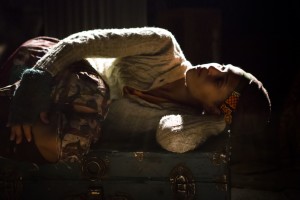Memory is a dangerous place to live. It is often untrustworthy and filled with the lies we wish were the truth. It is also the place we're most likely to encounter those we wish we could forget. For Bemadette, in Nilo Cruz's brilliant Sotto Voce, memory is both where she most wants to be and the location she would most like to forget. Watching her journey to her past and towards her future makes for a rewarding theatergoing experience — one that is powerful, emotional and worth remembering for many years to come.
Sotto Voce focuses on Bemadette, brilliantly portrayed by Franca Sofia Barchiesi, a reclusive writer whose only contact with the outside world is a young housekeeper, Lucila, played by Arielle Jacobs. Their world is rocked when a young man, Saquiel, brought to life by Andhy Mendez, comes seeking Bemadette’s advice for his fledgling writing career and, more importantly, with his most important story: the facts of what happened with a ship bound for Cuba in 1939. This ship carried hundreds of Jewish passengers attempting to escape Nazi Germany. One of those was Bemadette’s first love, a man who she both continually tries to bury in her memory and seeks to keep alive by never confronting the facts of his actual fate.
As a writer, Bemadette must enter the dangerous space of memory if she wants to finish her most important story: what actually happened to her love when he attempted to flee. Through her interactions with Saquiel, she is forced to retell moments of her past, but also to face her almost insurmountable agoraphobia. As someone who has not gone out in years, she will only rendezvous with the young Cuban student via the written and spoken word. He delights in these virtual visits, taking her both to sites in their adopted New York City and spots in her own mind. Simultaneously, Saquiel befriends and then seduces Lucila, who fears that having escaped her homeland of Colombia will turn out similarly to Bemadette’s abandonment of her hometown of Berlin. What if she forgets where she is from and can never go back?
All of the performances are effective and affecting. The conceit — which displays the writer and her student interacting physically to mirror their vocal and written meetings — works perfectly to develop the necessary emotions. There is a particular mood to this production, one brilliantly orchestrated by Cruz, serving double duty as writer and director. The sense of melancholy is consistently tempered by moments of humor and deep humanity. The intimacy, immediacy and honesty of this production are perhaps its greatest elements. No performer deserves more credit for this than Barchiesi. She makes Cruz’s poetry sing while understanding the many variations and complicated levels of this compelling woman.
The topic here is one that is more than deserving of a play. Theater, at its best, asks its audience to confront and discuss content that might otherwise be ignored because it causes discomfort. This play is no wallflower when it comes to making hard observations and important commentaries. And yet, it never seems preachy or didactic. This is due in large part to the play’s style: these individuals seem to have at their disposal the perfect words for all of the things that they need to say. The events are given poetic poignancy by the way in which their speakers choose to elucidate them. I found myself both laughing and crying during the play and, perhaps most importantly, continuing to discuss the issues put forward long after the house lights had come up.
All in all, Sotto Voce is a play not to be missed. It sheds important light on an historical event while bringing to life very realistic and incredibly relatable characters. It is a heartfelt and meaningful piece of theater. It will give its spectators a memory they won’t soon want to forget. In fact, it may even inspire them to write their own histories into the poetry of memory as well.
Sotto Voce runs through March 9 at the Theater for the New City (155 First Ave). Performances are Wednesday through Saturday at 8 p.m. and Sunday at 3 p.m. General admission is $20; $15 for seniors and students. For tickets, call 212-254-1109 or visit www.theaterforthenewcity.net.
















